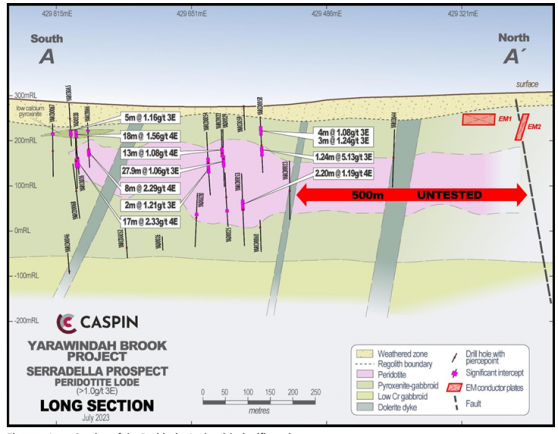Caspin Resources Ltd (ASX:CPN) has intersected further high-grade platinum group element (PGE) mineralisation in recent drilling at Serradella Prospect within the Yarawindah Brook Project in Western Australia.
The drill program returned strong results, including 18 metres at 1.56 g/t 4E (platinum+palladium+rhodium+gold), 0.33% nickel and 0.34% copper from 59 metres.
During the program, Caspin also received first-pass soil geochemical results from a new target in the north of the project area, which presents another opportunity for the discovery of near-surface PGE-nickel-copper mineralisation.
Looking ahead, this provides multiple, shallow early to advance-stage targets for further exploration and testing.
Significant advancements
Caspin CEO Greg Miles said: “It is pleasing to have received further high-grade PGE hits at the Serradella Prospect from the remaining assays of the program.
“We have made significant advancements in understanding the mineralisation controls at Serradella and recognise that high-grade mineralisation remains open and potentially close to surface.
“More broadly, we have commenced a review of past exploration and further interpretation of the Yarabrook Intrusion that could yield further opportunities.
“The intrusion is large with over 4,000 metres of strike and greater than 1,000 metres of thickness, with multiple intrusive components, some of which are very well mineralised.
“The intrusion has not been fully explored, and we expect there are further discoveries to be made.
“We have long recognised the mineral potential throughout the project area, so we are pleased to have identified a new soil geochemical anomaly in an area that hasn’t received any form of modern exploration.”
Key mineralised lodes
Extensions of key mineralised lodes remain open, including:
- More than 500 metres of the high-grade ‘Peridotite Lode’ strike not tested by drilling; and
- ‘Pyroxenite Lode’ open down-dip beyond the limit of drilling
The peridotite host unit is expected to continue at least another 500 metres beyond the extent of drilling, at shallow depths, which can be mapped by the strong magnetic response of the unit.
Long section of the peridotite lode with significant intercepts.
New target
In parallel with the drilling program at Serradella, Caspin has also expanded its soil geochemistry coverage which has identified a new coincident PGE-nickel-copper anomaly in the Balsana prospect, about seven kilometres to the north of Serradella.
The anomaly is about 1,000 metres in diameter and is coincident with a strong magnetic feature, interpreted to represent mafic or ultramafic intrusive rocks.
Importantly, not all of the magnetic feature is anomalous, thereby increasing the likelihood that the anomaly represents basement mineralisation rather than background lithology.
Miles adds: “The Balansa Prospect complements our other soil and EM targets on the Brassica Shear Zone.
“The extensions of high-grade mineralisation at Serradella, combined with the greenfields targets at Balansa and Brassica, provides a suite of prospective targets for further exploration and drill testing.”
Forward plan
Caspin is reviewing all previous drilling to characterise similar mineralisation controls, particularly at the Central Yarabrook, Ovis and Avena prospects, which could present further discovery opportunities.
At Balsana, the company is contemplating ground electromagnetic surveys followed by drilling programs during the upcoming summer season.
Furthermore, Caspin is also continuing to evaluate the mineralisation potential along the Brassica shear zone, which has numerous soil anomalies and airborne electromagnetic conductors along 19 kilometres of strike.
Miles adds: “In the meantime, we look forward to drilling results from the recently completed Mount Squires drilling program.
“The company drilled over 4,000 metres across a range of new rare earth element, gold, nickel and copper targets, most of which had never been drilled before.”
Read more on Proactive Investors AU
